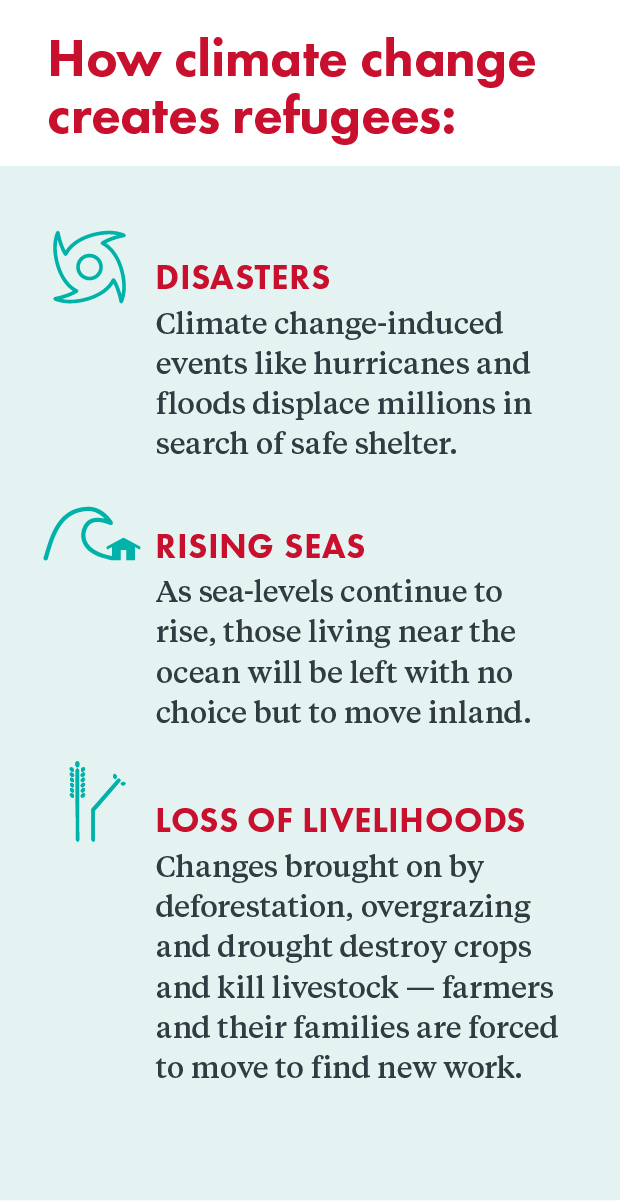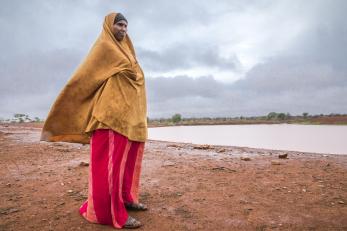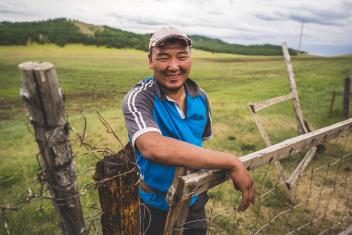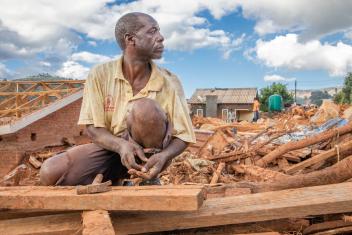The facts: How climate change affects people living in poverty

Around the world, people are experiencing both the subtle and stark effects of climate change. Gradually shifting weather patterns, rising sea levels and more extreme weather events are devastating evidence of both a rapidly changing climate and an urgent need for solutions.
While the impacts of climate change affect every country on every continent, they don’t do it equally. People already burdened by poverty and oppression often suffer the harshest consequences, while having the least ability to cope. Their struggle to earn a living, feed their families and create stable homes is made more difficult every day the climate crisis continues.
The increased frequency and intensity of extreme weather events like hurricanes, wildfires and droughts threaten lives in these front-line communities, driving people from their homes and jeopardizing food sources and livelihoods. All these effects increase the likelihood of more conflict, hunger and poverty.
Still, the people most at risk are persisting despite it, fighting to grow food, maximize dwindling resources and withstand recurring disasters. The actions people in hard-hit regions are taking every day to overcome the burdens of the climate crisis are just as vital as widespread solutions. And the steps we take now as a global community, including supporting those on the front lines who are braving the challenge, will determine our resilience for the future.
The time for this action is now, with the U.N. secretary-general naming 2021 a “make or break” year to address the climate emergency.
The climate crisis discriminates, but the efforts to fight it cannot. Mercy Corps partners with people and communities facing the starkest effects of climate change, connecting them to information and tools to protect themselves, overcome challenges and thrive in the changing environment.
Read on to learn more about how climate change triggers conflict and exacerbates hunger and poverty for these communities, as well as what Mercy Corps is doing to help them become stronger and more resilient in the face of change.
- What are the biggest effects of climate change?
- Who is most affected by climate change?
- How does climate change increase conflict?
- What’s the relationship between hunger and climate change?
- How does climate change create climate refugees?
- What’s the forecast for the future and climate change?
- How is Mercy Corps helping?
What are the biggest effects of climate change?
Climate change places compounded stress on our environment, as well as the economic, social and political systems people depend on for food, safety and income. Whether it comes in the form of unbearable heat waves, harsh winters or extreme weather events like the recent hurricanes in Puerto Rico and The Bahamas, climate change puts people’s lives at risk by undermining development and creating shortages of basic necessities, like food and water.

Climate change threatens the cleanliness of our air, depletes our water sources and limits food supply. It disrupts livelihoods, forces families from their homes and pushes people into poverty.
Research from 2015 revealed the planet had lost around one-third of its arable land in the previous 40 years, in large part due to climate disasters and poor conservation. And every year more trees and soil are lost. More than 1.3 billion people live on weakening agricultural land, putting them at risk of depleted harvests that can cause hunger, poverty and displacement. Soil, which is essential for healthy crops and ecosystems, is being lost between 10 and 100 times faster than it is forming, though recent research suggests conservation measures can help substantially.
Meanwhile, natural disasters have become more frequent and destructive. In 2019, 396 events — more than the annual average over the previous decade — affected 95 million people globally and caused $103 billion in economic losses. These damages can be nearly impossible for families living in poverty to overcome.
As climate events worsen, people are also threatened by more gradual changes, such as climbing temperatures and declining rainfall.
Droughts alone impact around 55 million people every year , and the damage hits the agriculture industry — the primary source of food and income for many people in developing countries — particularly hard. Between 2008 and 2018, more than 80% of drought damage was absorbed by agriculture in low- and lower-middle-income countries, and the crop and livestock losses caused by all natural disasters in these countries during the same timeframe equated to enough calories to feed 7 million people per year.
As these situations grow more desperate, food shortages can force families to leave their homes and migrate to other countries.
When there is no rain, like now, we get big challenges. There are no yields, and when you go to the shops you find that food prices have gone up, yet you are still jobless.
Simon, a farmer in drought-stricken Kenya
Climate change is also one of many root causes of conflict around the world: it leads to food shortages, threatens people’s livelihoods and displaces entire populations. Where institutions and governments are unable to manage the stress or absorb the shocks of a changing climate, instability will remain an ongoing threat.
Who is most affected by climate change?

While everyone around the world feels the effects of climate change, the most vulnerable are people living in the world’s poorest countries, like Haiti and Timor-Leste, who have limited financial resources to cope with disasters, as well as the world’s 2.5 billion smallholder farmers, herders and fisheries who depend on the climate and natural resources for food and income.
Increasingly unpredictable weather patterns, shifting seasons and natural disasters disproportionately threaten these populations, endangering their livelihoods and increasing their risk of poverty and hunger.


The majority of people living in poverty rely on agriculture and natural resources to survive. For these people, the effects of climate change — shifting weather, limited water sources and increased competition for resources — are a real matter of life and death. Climate change has turned their lives into a desperate guessing game.
As the effects of climate change increase for these populations, so must the ingenuity of our response.
How does climate change increase conflict?

Conflict is the primary cause of poverty and suffering in the world today. And it’s exacerbated by climate change.
By amplifying existing environmental, social, political and economic challenges, climate change increases the likelihood of competition and conflict over resources. It can also intensify existing conflicts and tensions.
In the Democratic Republic of Congo, shifts in the timing and magnitude of rainfall undermine food production and increase competition for remaining arable land, contributing to ethnic tensions and conflict.
And in places like central Nigeria and Karamoja, Uganda, where resource scarcity has been a long-standing challenge, climate change has further reduced pasture and water sources and resulted in increased competition and violence.
The land is insufficient. ... The relationship [between people] is no longer that good. Take farms and cattle for instance. Since the land is not enough, cattle tend to encroach into farmers' crops. It brings about trouble, crises and the involvement of law enforcement agents.
Habibu, pastoralist in resource-scarce central Nigeria
But while climate change can lead to conflict, it can also provide an opportunity for collaboration. These challenges present a unique opportunity for collective action and partnership in order to mitigate the impacts, and the security of front-line communities will depend on cooperation over conflict.
The community feels anxious because the flooding is quite disruptive of our daily activities, so we try to always communicate and coordinate to find solutions when flooding happens in our neighborhood. … I am happy to live in my current neighborhood because we handle the flooding issue together as a community.
Sagiman, community member in flood-prone Indonesia
In Uganda, Mercy Corps is helping one South Sudanese refugee form a friendship without borders ▸
What’s the relationship between hunger and climate change?
Climate change threatens the world's food supply.
Floods and droughts brought on by climate change make it harder to produce food. As a result, the price of food increases, and access becomes more and more limited, putting many at higher risk of hunger.
Undernutrition is the largest health impact of climate change in the 21st century. The number of undernourished people in the world has been increasing since 2014, reaching nearly 690 million — almost 9% of the global population — in 2019. The vast majority live in low- and middle-income countries — research shows hunger to be most prevalent in Africa and rising fastest in Latin America and the Caribbean. The number of undernourished people in the Latin America and Caribbean region increased by 9 million between 2015 and 2019.
Much of the increase is linked to progressively extreme weather and the growing number of conflicts, which can be driven or exacerbated by climate-related stresses. The 2020 Global Report on Food Crises recently reported its highest number of acutely food insecure people on record, some 135 million people across 55 countries and territories, in part due to climate shocks and natural disasters such as flooding, erratic rain, climate-induced displacement and the devastating locust invasion in East Africa.
How does climate change create climate refugees?

Rising sea levels, extreme weather events and prolonged drought force millions of people to lose or move away from their homes every year in search of food, water, shelter or jobs.
Nearly 70% of all new displacements in the first six months of last year were the result of weather-related disasters, with a total of 9.8 million people around the world driven from their homes by shocks like drought, hurricanes and landslides — around 50,000 people every day.

Meanwhile, gradual changes brought on by deforestation, overgrazing and decreased rainfall slowly transform pastures to dust, destroy crops and kill livestock, effectively challenging the livelihoods of millions of farmers. Many of these families are forced to leave their homes behind in search of basic necessities and new work.
And if sea levels continue to rise without intervention, many of those living near the ocean — about 40 percent of the world’s population — will be at risk of losing their homes.
Almost all of these displacements are occurring in low- and middle-income countries, where people have fewer options to cope with progressive shifts or sudden disasters.
What’s the forecast for the future and climate change?
The negative impacts of climate change continue to worsen and multiply at dramatic rates, and more ambitious global efforts are necessary to cut emissions and limit the effect of climate change on the planet.

Access to clean water is likely to become even more limited, and the risk of hunger and famine will become even greater than it is today. By 2050, climate change reportedly has the potential to increase the number of people at risk of hunger by as much as 20%. The majority of those at risk live in Africa.
Tens of millions of people are expected to be forced from their homes in the next decade as a result of climate change. This would be the biggest refugee crisis the world has ever seen.
In 2017, the World Health Organization reported climate change is expected to kill an additional 250,000 people every year between 2030 and 2050, from climate-linked malnutrition, malaria, diarrhea and heat stress, all while continuing to jeopardize clean air, safe drinking water and sufficient food supply.
A crisis of this scale demands a united, immediate response of an even greater magnitude: one in which we work together to help communities worldwide confront the challenges of today while developing solutions for a safer, more stable future.
How is Mercy Corps helping?

Mercy Corps is helping people around the world adapt to climate change.
In places as diverse as Puerto Rico, Ethiopia, Mongolia and Indonesia, we listen to the climate challenges each community is facing and collaborate with them to develop solutions that will make the biggest impact. This work aims to remove barriers so communities can adapt, innovate and thrive amidst the impacts of climate change, particularly in three areas: disappearing livelihoods and rising hunger, increasing disaster and escalating violence.
Read more about our approach to climate-resilient development ▸
1. Building climate-resilient livelihoods and food sources
We support farmers and communities to better manage unpredictable weather patterns and maximize the resources they do have by connecting them with information, tools and services for growing hardier yields and raising livestock.
This includes helping farmers diversify their crops and redesign their farmland to improve their productivity and protect the soil, so they are better equipped to continue growing food and earning income in the face of drought. We also train herders on how to keep their animals healthy in drier conditions.

We link farmers and herders with banking services, such as loans and savings, as well as insurance products, that can help them protect their work and build a financial safety net. And we use mobile technology to connect them to critical information — weather updates, crop prices, e-learning — they can leverage to make informed choices on when to plant and sell and how to treat their crops and animals.

We also work with communities to strengthen and adapt their local market systems and secure economies that can thrive in a changing climate.
This includes introducing new, locally-produced agricultural supplies, such as drought-resistant seeds and drip irrigation, which helps farmers in places like water-scarce Jordan use limited resources more efficiently. We also link farmers in Afghanistan and other farming communities with new buyers, enabling individuals to increase their income and encouraging job creation in rural economies.
How we're helping herders build resilience in rural Ethiopia ▸
2. Helping communities prepare for worsening disasters
We help communities rebound from disasters while strengthening them to be more resilient for the future. We do this by partnering with them to decrease the risk of damage while equipping themselves to respond in the event of another disaster.
In flood-prone places, like Tajikistan and Indonesia, we’ve worked with communities to reinforce river embankments and prepare for future flooding by developing early warning systems and evacuation routes.

In Puerto Rico, where hurricanes are an annual threat, we’ve collaborated with existing community centers to create resilience hubs supplied with solar power, water and emergency essentials, so community members won’t be dependent on external aid to survive in the event of a future disaster.
Around the world, we teach students and community members about climate impact, risk management and disaster preparedness so they’re better prepared for emergencies. And we collaborate with local and national governments to strengthen their communities’ resilience to weather-related risks, including improving the way water and land is managed, building disaster response plans and developing policies that reduce vulnerability to climate change.
CASE STUDY: A governance approach to building climate resilience in Indonesia ▸
3. Addressing conflict caused by climate change
To resolve climate-related tension and stop violence before it starts, we help communities and their governments build an environment in which people work together to protect and share natural resources.
We provide opportunities for people to overcome their differences and collectively manage resources, like training community leaders to build conflict management skills and helping people identify shared concerns and solutions.
If we work as a team in unity then all work will be easy, but if we keep fighting within each other then we can do nothing.
Gayadin, farmer in flood-prone rural Nepal
In Uganda, for example, we facilitate resource-sharing agreements and promote cooperation between communities to reduce conflict. In Nigeria, we teach farmers and herders how to peacefully resolve disagreements over land and water that could otherwise spiral into violence.
Just as the fight against climate change is a collective effort, we see the shared experience of its local impacts as an opportunity for cooperation and collaboration that can reduce the risk of conflict and foster a better future.











